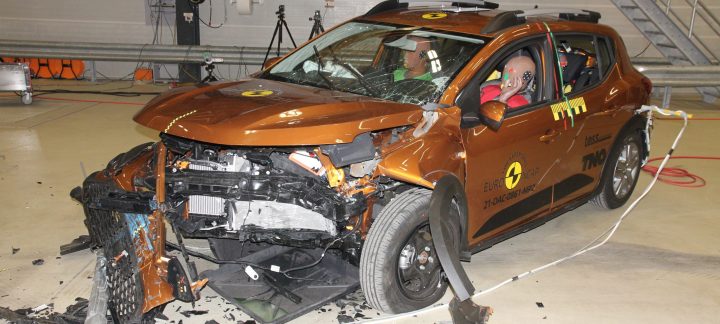In the latest round of new vehicle assessments, Euro NCAP tests highlighted some major safety flaws with the Dacia Sandero after it only scored a two-star Euro NCAP Safety Rating.
Euro NCAP’s fully-transparent testing protocols were overhauled in 2020 and are the toughest and the most exacting ever, ensuring European vehicles remain the safest in the world.
The Sandero was let down by its lack of ‘active’ safety technology that has the potential to prevent serious accidents. It scored a lowly 42% in this category because it only has speed assistance and a basic autonomous emergency braking (AEB) system.
The level of protection the car offers to other vulnerable road users (VRU) through its active safety systems was also disappointing. Because the Sandero’s radar-only AEB system cannot detect pedestrians and cyclists, putting these VRUs at increased risk. The VRU score was therefore only 41%.
Passive capability adds to concerns
The Sandero’s adult occupant protection score of 70% was also way behind the class leaders in the supermini segment. The five-star rated Honda Jazz and Toyota Yaris, both tested to the same protocols as the Sandero, scored 87% and 86% respectively in this assessment.
Particular concerns, relating to the Sandero’s structure, pointed to a risk of injury from the dashboard to front seat occupants’ knees, femurs and chest in the event of a frontal impact. Protection was rated as only marginal in this regard. The side impact test also revealed a marginal level of protection against chest injury.
The Sandero’s child occupant safety score was 72% and highlighted issues with the rear restraints. In the frontal offset test, protection afforded to the 10-year-old dummy’s chest and neck was rated as weak, while the six-year-old dummy’s neck protection was marginal.
To put the Sandero’s overall two-star rating into context, no other car has scored two stars or less in terms of relative performance since 2018 and the car’s VRU score is the worst recorded during Euro NCAP testing since 2013.
Cross-brand inconsistencies
The Sandero is positioned at the budget end of the supermini segment, but safety experts Thatcham Research believe Dacia – part of the Groupe Renault brand family that also includes Renault and Nissan – is putting price before safety.
Matthew Avery, Thatcham Research’s Director of Insurance Research, said: “The Sandero’s Euro NCAP rating is a major disappointment and it’s therefore not a new car we would recommend. There are other cars in the supermini segment, whether new or a few years old, that can offer better safety and value for money.”
“Renault and Nissan both have five-star rated models in the supermini segment with the Clio and Micra, and the Sandero is closely related to these vehicles. But it appears Dacia has made a clear decision not to prioritise safety, exposing occupants and other road users to increased risk.
“With this car, the active safety capability isn’t where we would like it to be and that’s a big disappointment in 2021.”
 Vehicle safety standards within the Electrical Vehicle (EV) market have been further boosted after the Volkswagen ID.4 and Skoda Enyaq emerged from the latest round of Euro NCAP assessments with maximum five-star safety ratings.
Vehicle safety standards within the Electrical Vehicle (EV) market have been further boosted after the Volkswagen ID.4 and Skoda Enyaq emerged from the latest round of Euro NCAP assessments with maximum five-star safety ratings.
As family-focused SUVs, both cars are expected to be extremely popular model choices within an EV market that continues to go from strength-to-strength. The SMMT revealed this week that there are now 500,000 EVs on UK roads.
The ID.4’s five-star success comes hot on the heels of the identical rating awarded to its ID family counterpart, the ID.3, at the end of 2020.



